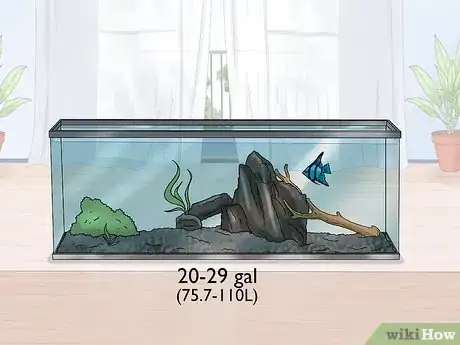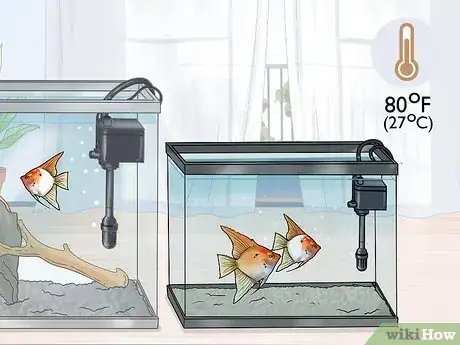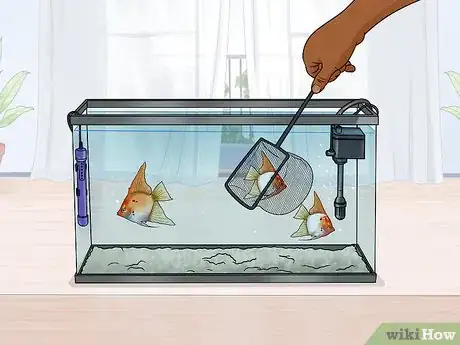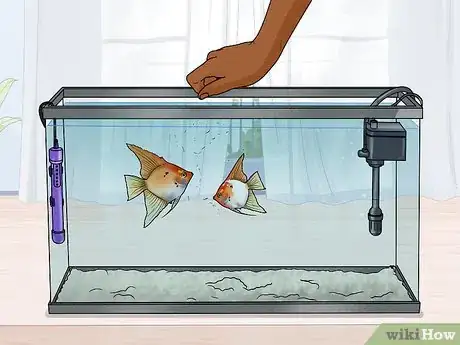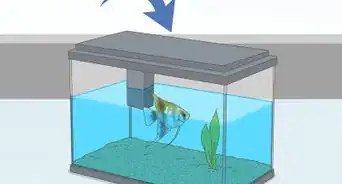wikiHow is a “wiki,” similar to Wikipedia, which means that many of our articles are co-written by multiple authors. To create this article, 32 people, some anonymous, worked to edit and improve it over time.
There are 9 references cited in this article, which can be found at the bottom of the page.
wikiHow marks an article as reader-approved once it receives enough positive feedback. This article received 17 testimonials and 91% of readers who voted found it helpful, earning it our reader-approved status.
This article has been viewed 416,842 times.
Learn more...
Angelfish are a favorite of freshwater aquarium hobbyists for their unique appearance. With triangular bodies, bold stripes and long fins, this elegant, easy-to-keep tropical fish will beautify any freshwater tank. Originally from South America and primarily found in the Amazon, these attractive fish have adapted well to being kept as pets in aquariums that are properly set up to meet their needs. In addition to their many positive attributes, angelfish are also relatively easy to breed in captivity. Under the right tank conditions, those who enjoy keeping angelfish can watch them hatch and grow into adults. Once you learn how to breed angelfish, you will be well on your way.
Steps
Setting the Right Conditions for Breeding
-
1Set up a freshwater aquarium large enough to prepare breeding angelfish. Try to choose a tank that is at least 20 gallons (75.7 L) and ideally 29 gallons (110 L) large.[1] Your angelfish pair will do best with plenty of space. In cramped quarters, angelfish won't feel secure and will fail to breed.
- Try also to place the angelfish in a tank that is tall. Mature angelfish can grow up to a foot long from their dorsal to their anal fin, meaning you'll want to accommodate their unusual length.
-
2Test the pH of your water. In their natural habitat, freshwater angels live in soft water that's slightly acidic. For best results, make sure that their aquarium water has a pH of between 6 and 8.0, with the ideal range being 6.5 and 6.9.[2] Angelfish are relatively hardy when it comes to pH and tolerate a wide range of water conditions, but you want to try to shoot for this happy medium in order to produce a contented breeding pair.
- If your water isn't in the ideal pH range, a de-ionization filter or reverse osmosis (R.O.) filter can do the trick. These are usually attached to your main water supply, and can run from fairly cheap to incredibly expensive. They are, however, effective.
- Try not to use chemicals to alter pH if at all possible. Chemical pH solutions alter the alkalinity or acidity of the water much too drastically, something your angels are sensitive to. Angels may fail to breed or, worse, die off if the pH swings too drastically from one extremely to another. Ensure that the aquarium water pH doesn't change more than 0.2 per day.
Advertisement -
3Set the water temperature.[3] Again, because angelfish are very accommodating fish, they tolerate a pretty wide range of temperatures. But they do thrive when the water temperature is right in their wheelhouse, between 78° and 86° F (22° and 27° C), with 82° F being a good target.[4]
- Keep in mind the tradeoffs of different water temperatures. Warmer water is arguably better for angels' immune systems, whereas colder water increases their lifespan.
-
4Put a good filter in your aquarium.[5] Angelfish are ideally suited to strong currents, so be careful about using a high flow filter, which could tire them out unnecessarily. Better to use a sponge filter, gravel filter, or both — that way, your angels will have energy for love and their small fry won't be sucked up into the filter when they hatch.
- Do at least 50% water change each week either as part of regular cleaning activity.
-
5Feed your angelfish properly. Angels typically aren't very picky eaters, but they do enjoy their fresh foods and generally have very robust appetites. Shoot to feed your angels at least two or three times a day, being careful not to overfeed them.[6]
- Give your angels 3 to 5 minutes to feed on any food you give them. Any food that hasn't been eaten after 5 minutes should be removed from the tank to promote clean water.
- If introducing a new kind of food to your angels, don't feed them at all for one or two days. Then, when you do introduce the new food, provide enough for one or two bites, supplemented with regular food. This should be enough to get them excited about the new kind of food.
- A regular diet may consist mainly of dried flake food, supplemented with brine shrimp and blood worms. Live food, apart from brine shrimp, isn't recommended for angels because of the chance of disease.
Setting in Motion Breeding
-
1Sex your angels to isolate a breeding pair. Sexing young angelfish (body size is smaller than a quarter) is next to impossible, so don't even bother. With more mature angelfish, sex can be distinguished by looking at the tubes of the vent. With males, the tube is smaller, pointy, almost triangular. Female tubes are larger and square, like an eraser on a pencil.
-
2Use other common characteristics to sex your angelfish. Looking at the tubes of the fish is the single most reliable way of sexing. But taken together, other characteristics can help you determine the sex of an angel. Just remember not to cue in on any single characteristic when sexing — look at the whole picture.[7]
- Females tend to be more round while males tend to be more angular.
- Female Dorsals are held slightly backward, while male dorsals are fully upright, at almost a 90 degree angle to the head bump.
- Females tend to hold Ventrals closer to body, while males hold ventrals more erect
- Females have a more smoothly sloped head, whereas males often have a distinct bump on their heads.
-
3Alternately, purchase a breeding pair.[8] If you're not sure whether you're dealing with males or females, it can be useful to simply purchase a breeding pair. When you do this, make sure they are younger and have proven to breed good fry. This is more expensive than sexing your own, but often it's a more reliable and efficient way of breeding quickly.
-
4Wait for breeding males and females to pair off if you are keeping more than two angelfish. This may take 6 to 7 months, or even longer for angels that are wilder or weaker. In a large tank, you'll notice one male and one female essentially pairing off, sending away on bothersome third party. Wait a day or two just to make sure the pair is really a pair.
-
5Isolate any breeding pairs in a separate spawning tank. Make sure that the water chemistry is the same as the tank they were just in. Angels feel more secure and in the mood for procreation when left to themselves. Put them in at least a 20 gallon (75.7 L) tall tank that's elevated so that you move by the tank at your chest- or eye-level. This will create fewer distractions, and ultimately, a happier couple.
- In the spawning tank, provide a surface for the angels to deposit their eggs on. A spawning cone, spawning mop, or simply a piece of slate are items breeders often choose. Angels have also been known to lay their eggs directly on the water filter, for example.
Waiting for the Angels to Spawn
-
1Wait for your breeding pair to spawn. Sometimes, breeding pairs spawn only days after being transferred to the spawning tank. In other cases, it can take several weeks of waiting and a little bit of prodding for them to feel comfortable enough to produce fry. Here are some things you can do to encourage breeding:[9]
- Raise the temperature a few degrees if it's currently under 80 °F (27 °C).
- Do a 75% water change, being careful to condition the water and make sure the pH and softness of the water is close to what the angels are accustomed to.
- Feed them a bit more than usual with high-quality freeze dried food.
- Give them more security by adding additional plants, spawning mops, or other fibrous, decontaminated props.
- Try a larger aquarium if your tank is at or below the 20 gallon (75.7 L) mark.
- Place another angelfish or another breeding pair close to, but still separate from, their aquarium. Sometimes, the sight of another angelfish will get them breeding.
-
2If all else fails, pair the angels up with different mates. If you've waited in vain for your breeding pair to do the deed, and you've tried all of the above suggestions, it may be time to play matchmaker again. There's a good chance the breeding pair isn't actually compatible, and you'll want to find a different mate for each fish. Try placing them back into a bigger aquarium and wait for them to pair off with other mates.[10]
-
3Let the angelfish rear their own fry if desired. Angelfish normally care for their own spawn so leave them to it once they have spawned and disturb them as little as possible. Any form of undue stress or unexpected routine can cause the angelfish to start to eat their own fry.
- As the breeding pair raises their fry, continue feeding the breeding pair as before, taking note that they may not be as hungry. Remove any unwanted or uneaten food immediately after feeding and take pains to ensure the water quality is high and uncontaminated.
- Occasionally you get a pair of angels that eat their fry. When this happens, you have no alternative but to remove the cone or slate with the eggs to another tank containing identical water and raise them artificially.
-
4Raise the fry artificially if you need to.[11] Transfer the fry to a clean 1 gallon (3.8 L) tank with an airline feeding medium-sized bubbles into the water. Treat the 100% filtered water with a fungicide, then with Acriflavin, an antibacterial. Transfer the fry on the spawning slate or mop so that it's facing the bottom of the tank and close to the airline. Consider keeping the tank in the dark to prohibit the harmful growth of bacteria.
-
5Wait for the fry to hatch after about 60 hours in 80 °F (27 °C).[12] At this stage, they'll be simple wrigglers, and won't need to eat anything. After 5 days in this stage, they become free-swimming and will start to need food (brine shrimp work well). Small, frequent feedings are best. After the fry begin to swim in a cloud, they should be transferred to a medium sized (2.5 gallon to a 10 gallon) tank.
Community Q&A
-
QuestionI have a community tank. Will the other fish eat my angel's eggs?
 Community AnswerYes - if not when they are eggs, definitely once they become free swimming. Get a separate tank for them, or a divider.
Community AnswerYes - if not when they are eggs, definitely once they become free swimming. Get a separate tank for them, or a divider. -
QuestionDo Angelfish eat their own eggs?
 Community AnswerYes, they might eat their eggs if they are stressed or feel threatened. There are also times when first time parents eats their eggs. They'll learn how to breed properly over time.
Community AnswerYes, they might eat their eggs if they are stressed or feel threatened. There are also times when first time parents eats their eggs. They'll learn how to breed properly over time. -
QuestionAt what age can angelfish be sold?
 Community AnswerIf you are selling them to a person, a 4-5 centimeter body is the best size. If you're selling them to a pet store, ask them what size they prefer.
Community AnswerIf you are selling them to a person, a 4-5 centimeter body is the best size. If you're selling them to a pet store, ask them what size they prefer.
Warnings
- Do not do sudden temperature changes to your angelfish tank's water. This can shock the fish. If you want to boost the temperature to encourage breeding, do it slowly and only by a few degrees.⧼thumbs_response⧽
- Do not forget to do regular, partial cleanings of your angelfish tank water. The pair are very sensitive to dirt and debris when breeding and are not likely to breed in dirty water.⧼thumbs_response⧽
Things You'll Need
- Aquarium and filter system
- Aquarium plants
- Driftwood
- Quality fish food
- Water conditioner
- Large glass jar or separate aquarium for the angelfish eggs
- Live or freeze dried fish food to stimulate breeding
References
- ↑ https://www.buildyouraquarium.com/complete-freshwater-angelfish-set-care-guide/
- ↑ https://animals.mom.me/proper-ph-range-for-angelfish-12269625.html
- ↑ https://www.firsttankguide.net/heater-setting.php
- ↑ https://www.buildyouraquarium.com/complete-freshwater-angelfish-set-care-guide/
- ↑ https://www.buildyouraquarium.com/complete-freshwater-angelfish-set-care-guide/
- ↑ https://www.buildyouraquarium.com/complete-freshwater-angelfish-set-care-guide/
- ↑ https://www.myaquariumclub.com/how-to-tell-if-an-angelfish-is-male-or-female-8029.html
- ↑ https://petponder.com/angelfish-breeding
- ↑ https://www.fishlore.com/Articles/BreedingAngelfish.htm
About This Article
Before you start trying to breed angelfish, make sure you have male and female adult fish by looking at their tubes, which are pointier and triangular for males, and square and larger for females. When you notice two angelfish have paired off from the rest of the fish, transfer them to a breeding tank and provide a surface for them to leave their eggs on, like a piece of slate. If a pair is taking longer to spawn, try increasing the tank's temperature by a few degrees if it's below 80 degrees F. For tips on how to set the pH level in your tank or when to pair the angels with different mates, read on!
